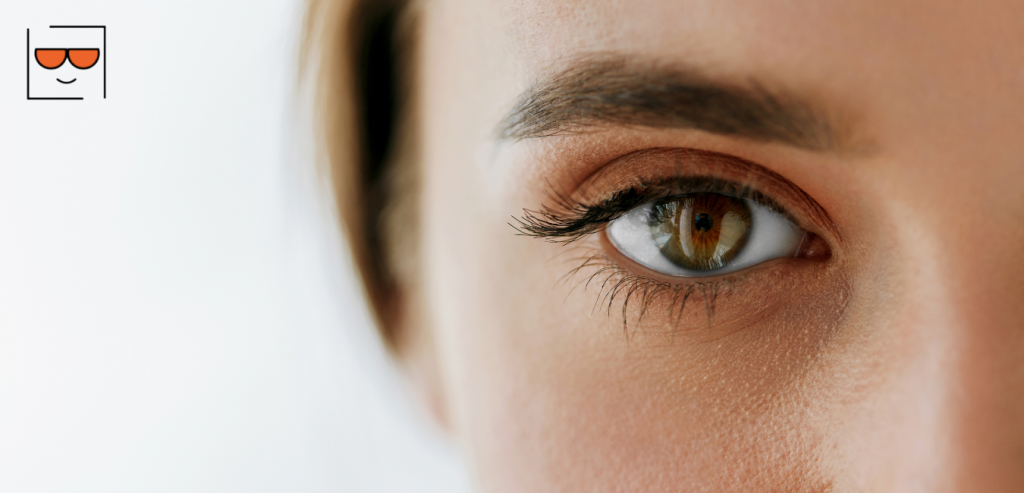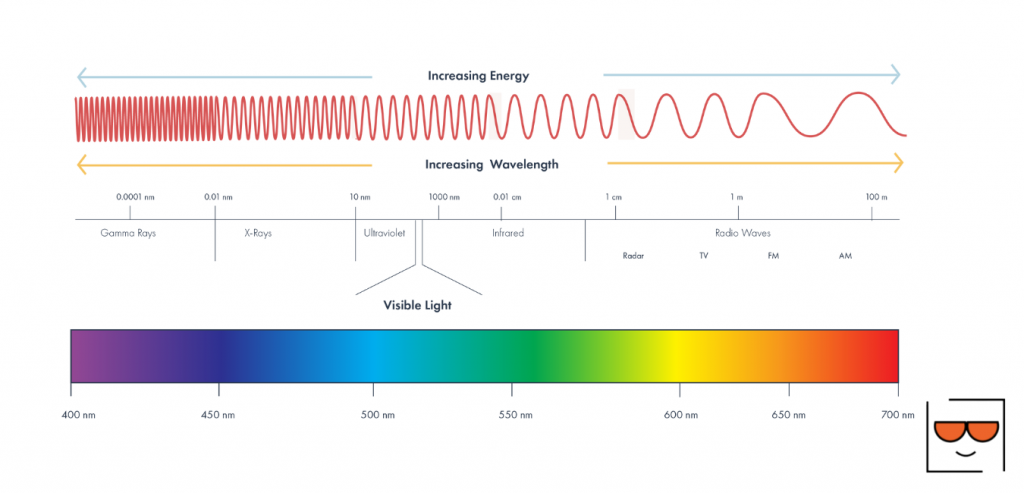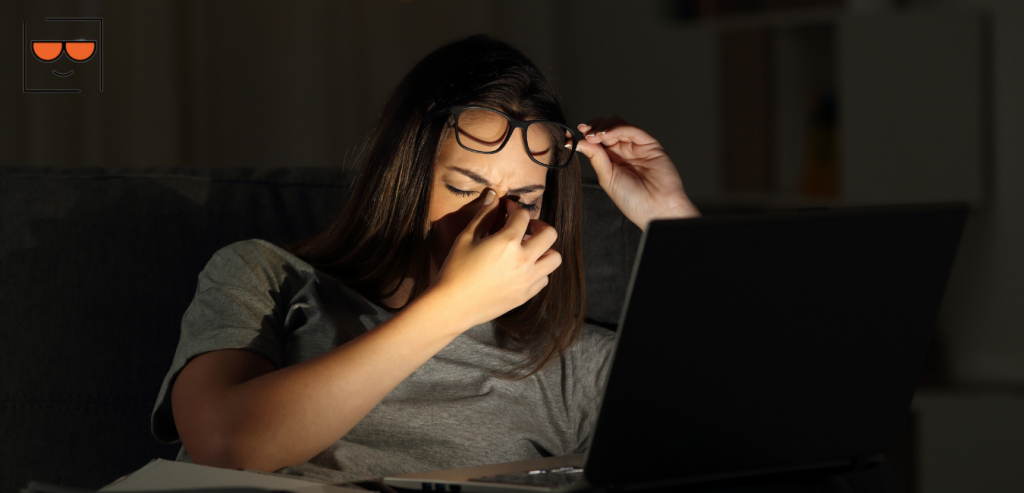
Whether we are scrolling through our phones, watching television, or staring at our computer monitors, one thing is sure, and screens have become a significant part of our daily lives. Chances are you’re looking at a screen right now to read this article. As our lives become more dependent on technology for both work and pleasure, should you be concerned about the blue light streaming off your screen?
Here’s a look at what blue light is and its harmful and beneficial effects on your health.
What is Blue Light?

The world around you pulses with electromagnetic energy. You depend on this energy every hour of the day to interpret the world as you know it. For example, you are using electromagnetic energy when you turn on your radio, send a text message, watch the news, or heat some leftovers in the microwave. Electromagnetic energy travels in waves and spans a broad spectrum from long radio waves to short gamma rays.
Most electromagnetic waves are undetectable to the human eye. However, a small portion of this spectrum referred to as visible light can be. When you see a rainbow, you see the visible light spectrum. The light we can see is a combination of red, orange, yellow, green, blue, indigo, and violet light. Each has different energy and wavelength. For example, visible light waves can vary in length from violet light at 380 nanometers to red light at 700 nanometers. Rays on the red end of the spectrum are longer wavelengths with less energy. On the other hand, violet rays have a shorter wavelength that is high energy.
Blue light has a wavelength range from 415 to 495 nanometers. As a result, the light that looks white can have a significant blue component. When light waves in the blue-violet range hit the eye, a unique process referred to as photoreversal occurs, exposing the eye to a higher amount of wavelengths from the blue end of the spectrum.
Exposure to Blue Light
Like other colors of the visible light spectrum, blue light is all around you, from the sun to the lights in your home. Humans are being exposed to more blue light than ever before due to the widespread use of devices relying on light-emitting diode (LED) technology. Modern lighting, including LED lights and compact fluorescent lamps (CFLs), can be a vital source of blue light, although bright and energy-efficient. 35% of LED light and 25% of the light from compact fluorescent lamps that are “cooler” or have a whiter light source emit higher proportions of blue light. Other sources of blue light include televisions, laptops, smartphones, tablets, and other such electronic devices. However, the blue light exposure you receive from lighting and screens is small compared to the amount of exposure received from the sun. During the day, however, 25% to 30% of sunlight is composed of blue light. And yet, there is concern over the long-term effects of blue light exposure from screens because of the proximity and duration spent looking at them.
Age can also be a factor when determining how much exposure we receive to blue light. For example, a 2011 NEI-funded study, Light-emitting diodes (LED) for domestic lighting: any risks for the eye? found that children’s eyes absorb more blue light than that of an adult from digital device screens.
How Does Blue Light Affect the Eyes?

Eyes are equipped with structures that can help protect your eyes from some kinds of visible light. For example, the cornea and lens of your eye protect the light-sensitive retina at the back of the eye from damaging UV rays. However, these structures do not prevent blue light from seeping into your eye. With the amount of exposure our eyes have to blue light, there is no doubt why ocular health experts have expressed concerns.
In a 2020 study published by the Indian Journal of Opthalmology, they found that during the COVID-19 lockdown, 32.4% of the studies population used a blue-light-emitting device for 9 to 11 hours a day. Another 15.5% used their devices for 12 to 14 hours a day. Thus, technology and the dependency on screens have increased exponentially since the beginning of the pandemic, increasing exposure to blue light.
Blue light and Macular Degeneration
Age-related macular degeneration or AMD is the number one cause of sight loss in individuals over 50. This occurs when a structure in the back of the eye, the macula, becomes damaged with age. As a result, you lose the ability to see through the center of your field of vision. Objects and details may still be able to be seen using peripheral vision. However, things or elements within your direct line of sight become blurred, and over time impossible to see.
Ophthalmologists and researchers do not believe there is a verifiable link between the use of LED or blue-light-emitting devices and AMD. However, animal studies have raised questions about whether blue light could speed up the process of macular degeneration. Some studies have even suggested that the continued exposure to blue over time could ultimately damage the retinal cells leading to vision issues such as AMD.
Blue Light and Digital Eye Strain
Blue light from computer screens and other digital devices for an extended period has led to digital eye strain. When people use computers, laptops, and other digital devices, they tend to blink less. Blinking helps to keep the eye moist and reduces eye strain.
Digital eye strain can vary in symptoms based on the individual. Symptoms of eyestrain include sore or irritated eyes, dry eyes, tired eyes, headaches, facial muscles fatigues from squinting, and difficulty focusing. For more information on eyestrain and blue light, look at Eyestrain & Blue light: Prevention.
Blue Light and Sleep
While there is still much debate on the long-term effects of blue light on the human eye, ophthalmologists and researchers can agree that there is an effect of blue light on your sleep-wake cycle.
Light sensors in both your eyes and your skin can perceive the difference between daylight and night. Your body can recognize the intense blue light waves of the daylight and the warm redder tones that signal the day is at a close. When the warm redder tones of light of the night start to set in, the sensors in your eye prompt your body to release your body’s natural resource of melatonin. Melatonin is a sleep-inducing hormone in the brain that regulates the body’s circadian rhythm and energy.
However, when you are exposed to blue light in the evening through digital devices and white light (which contains blue light), your body does not recognize it is night and prevents the release of your body’s natural stores of melatonin to induce sleep. By not releasing your body’s natural store of melatonin, your sleep cycle is delayed or disrupted, which can develop severe issues for concern. For more information on blue light and its effects on sleep, look at Blue Light Filters: Fighting Insomnia and Top 3 Reasons Why You Can’t Fall Asleep at Night and How to Prevent Them.
Health Benefits of Blue Light

Exposure to blue light can help alert, boost memory and cognitive function, and potentially improve seasonal depression.
Blue Light and Staying Alert
Blue light can have some adverse effects on your eyes and body. However, depriving yourself of blue can be just as harmful. Exposure to blue-enriched light increases reaction times and stimulates alertness when you are not at your peak performance time in the day. Thus, it can boost alertness, help with memory and cognitive function, and even elevate your mood.
Blue light regulates the body’s natural wake and sleep cycle, often referred to as the circadian rhythm. Exposure during daytime hours can help maintain a healthy circadian rhythm. However, exposure to blue light at night can disturb your wake-sleep cycle. As with everything, moderation is key.
Boost memory and cognitive function
Exposure to blue light can boost memory and cognitive function in the brain. In 2017, participants of a study had a 30-minute “washout” period of either blue light or amber light to see the effects light has on cognition function. Those exposed to blue light had an increase in verbal memory and memory consolidation tasks afterward. However, participants exposed to amber light did not perform as well as those exposed to blue light.
Potentially Improves Seasonal Depression
Blue light has become one of the most go-to treatments to relieve seasonal affective disorder and depression when combined with antidepressant medications. Seasonal affective disorder (SAD), also known as the “winter blues”, is a depression with worsening symptoms in the fall and winter months caused by a chemical imbalance in the brain due to shorter daylight hours and reduced sunlight.
In people with SAD, melatonin levels remain high in the morning, which can lead to depression, anxiety, and a lack of energy during the day and distribution with their sleep-wake cycle. Blue light can be used at specific wavelengths to achieve similar effects as sunlight. By suppressing melatonin levels in the morning, blue light therapy can increase energy levels and alertness during the day and improve night sleep, both of which can contribute to your overall wellbeing and happiness. Light therapy also helps to boost serotonin, another hormone that regulates mood and emotions.
Blue Light in Moderation

Blue light is all around us, pulsing through the natural sunlight as well as our favorite device. It is a part of our daily lives, helping our bodies prepare for the day. However, as with everything, moderation is key. Although its long-term effects are still unknown, blue light can create significant damage to our bodies and mind. With an increased dependency on LED and blue light sources, limiting the amount of exposure within your evenings is essential.
Limiting your exposure to blue light in the evening does not mean you have to give up your favorite electronics. Whether you need to check your email or scroll through social media, limiting your exposure to blue light using filters is possible. Blue light filters cover the screen of your electronic devices to stop blue light from entering your eyes. By limiting the amount of your blue light exposure in the evening, you will be able to sleep more sound, prevent eye strain and future eye risks. Ultimately, although it has health benefits, blue light can still be harmful if you are over-exposed, blue light filters help to moderate your intake of blue light.
Ready to limit your blue light exposure?
Start Blocking Blue Light Today!
